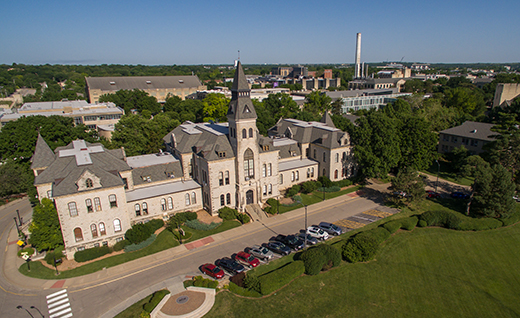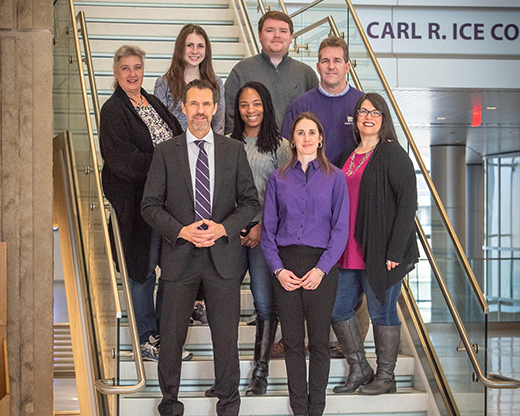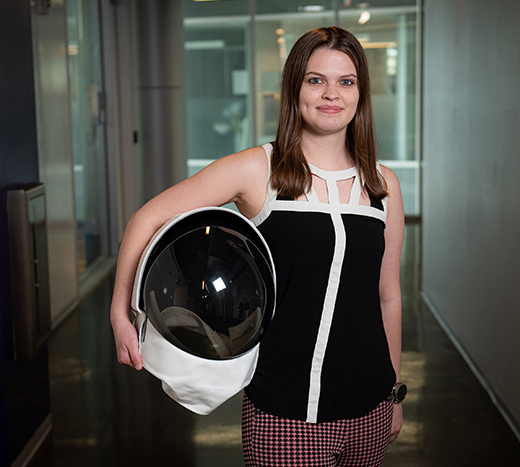05/12/21
K-State Current - May 12, 2021
K-State Current is a weekly news update for the Kansas Board of Regents to apprise the Regents on a few of the many successes and achievements made by K-State faculty, staff and students.
K-State News
Top value: Survey ranks Kansas State University best educational value in state
 Kansas State University graduates' income-earning power continues to lead the state, making K-State the best educational value in Kansas, according to a recent national study.
Kansas State University graduates' income-earning power continues to lead the state, making K-State the best educational value in Kansas, according to a recent national study.
Financial technology company SmartAsset ranks the state's best college value based on return-on-investment comparisons of starting salary, tuition, living expenses, student retention rate and scholarships awarded among 10 Kansas colleges and universities.
"A Kansas State University education continues to be a great investment for our students," said Charles Taber, university provost and executive vice president. "Our graduates command excellent starting salaries, and the financial value of this investment only grows over their lifetimes. In addition, a K-State education carries tremendous non-monetary value, preparing students to be leaders and engaged citizens in our communities."
The study showed new K-State graduates entering the workforce earn an average starting salary of $53,800, which is an increase of $1,300 from the university's average starting salary in 2020.
"K-State is a great value for students as this survey shows," said Karen Goos, vice provost for enrollment management. "We are committed to student success during their time here and beyond. Our most recent survey shows 95 percent of our K-State graduates are working or continuing their education after they receive their degree and earning higher starting salaries than anyone in the state."
The university also tied for the lead in student retention at 86%, which is an increase from 2020. Student success is vital to the university's land-grant mission. The university offers many programs to ensure students achieve their educational career goals, including K-State First for first-year students, the First Scholars program for first-generation students, the Academic Achievement Center and the Career Center.
Other Kansas schools surveyed included the University of Kansas, Pittsburg State University, Fort Hays State University, Washburn University, Emporia State University, Wichita State University, Baker University, Southwestern College and Friends University.
K-State Center for Hazardous Substance Research to receive $5 million in continued EPA funding
 This January 2020 file photo shows members of the K-State Technical Assistance to Brownfields program, which has been selected to receive $5 million in EPA funding for continued assistance with reuse and redevelopment of brownfields. The program includes, counterclockwise from front left, Blase Leven, TAB program director; Daena Blair; Maggie Egbarts; Jennifer Clancey; Scott Nightingale; Zach Etzel and Cait Riordan, student interns; and Sheree Walsh.
This January 2020 file photo shows members of the K-State Technical Assistance to Brownfields program, which has been selected to receive $5 million in EPA funding for continued assistance with reuse and redevelopment of brownfields. The program includes, counterclockwise from front left, Blase Leven, TAB program director; Daena Blair; Maggie Egbarts; Jennifer Clancey; Scott Nightingale; Zach Etzel and Cait Riordan, student interns; and Sheree Walsh.
The U.S. Environmental Protection Agency has selected the Kansas State University Center for Hazardous Substance Research to receive a $5 million grant to continue brownfield revitalization work.
K-State is one of six organizations nationwide that will receive a total of $11 million in grants to help communities across the country under the Technical Assistance to Brownfields, or TAB, program. The Center for Hazardous Substance Research will use the funding to continue the K-State TAB program. K-State will provide training and technical assistance in EPA regions 5, 6, 7 and 8, and lead nationwide efforts with the five other organizations.
"We are privileged and honored to be selected to continue serving communities and tribes across EPA regions 5, 6, 7 and 8," said Blase Leven, director of the Center for Hazardous Substance Research and director of the K-State TAB program. "This area is like none other, and we look forward to making new friends and working with old ones to bring brownfield revitalization dreams to life."
A brownfield site is real property where expansion, redevelopment or reuse may be complicated by the presence or potential presence of a hazardous substance, pollutant or contaminant. EPA's Brownfields Program empowers states, tribes, communities and other stakeholders to work together to prevent, assess, and safely clean up and sustainably reuse brownfields.
The TAB program funds organizations such as K-State that work with a large team and network of partner organizations to provide technical assistance to communities and other stakeholders. It helps them tackle the challenge of assessing, cleaning up and preparing brownfields sites for redevelopment, especially in underserved, rural, small and distressed communities.
A part of the Carl R. Ice College of Engineering, the Center for Hazardous Substance Research conducts research, education and service pertaining to environmental topics. Through this center, K-State provides TAB assistance to communities as an independent resource and helps them with community involvement, better understanding health impacts of brownfield sites, site preparation activities, brownfield finance questions and information on integrated approaches to brownfield cleanup and redevelopment.
Learn more about the EPA funding.
K-State Faculty Highlights
APDesign architecture professor selected for Tyson Scholar of American Art program
 Joseph Watson, assistant professor of architecture in the College of Architecture, Planning & Design, has been selected for the 2020–2021 Tyson Scholar of American Art program. As part of the program, Watson will spend the summer at the Crystal Bridges Museum of American Art in Bentonville, Arkansas.
Joseph Watson, assistant professor of architecture in the College of Architecture, Planning & Design, has been selected for the 2020–2021 Tyson Scholar of American Art program. As part of the program, Watson will spend the summer at the Crystal Bridges Museum of American Art in Bentonville, Arkansas.
The Tyson Scholars of American Art Program supports research and writing on American art and visual and material culture, including architectural history and theory. Watson will use his time at the museum to advance his book manuscript, tentatively titled "The Skyscraper and the Suburb: Metropolitan Machinations in American Architecture, 1890–1940." The book explores architects' efforts to manage competing social, cultural, economic and environmental forces introduced by the automobile in the early 20th century.
Watson will be participating in a virtual roundtable on race and American architecture at the end of May as part of the Society of Architectural Historians' SAH Connects series. He will also present a paper on the environmental imaginaries embodied in the Standard Oil Building in New York as part of the "Architectural History and Climate Emergency" symposium sponsored by the Society of Architectural Historians of Great Britain taking place in mid-June.
The Tyson Scholars of American Art Program was established in 2012 through a $5 million commitment from the Tyson family and Tyson Foods Inc. Since its inception, the Tyson Scholars Program has supported the work of 46 scholars, attracting academic professionals in a variety of disciplines nationally and internationally.
K-State Student News
Laser focus: K-State graduate student lands data analysis internship with NASA
 A prestigious internship with NASA's Jet Propulsion Laboratory, JPL, is helping a Kansas State University student achieve her career goals.
A prestigious internship with NASA's Jet Propulsion Laboratory, JPL, is helping a Kansas State University student achieve her career goals.
Sarah Lamm, master's student in geology from Colby, began her remote internship in April with the Origins and Habitability Lab at the Jet Propulsion Laboratory on the InVADER — In-situ Vent Analysis Divebot for Exobiology Research — project. She is conducting data analysis of laser-induced breakdown spectroscopy, or LIBS, and Raman laser data collection experiments on hydrothermal vents on the ocean floor. The collected data helps to determine mineral compositions relevant to life on Mars and ocean floors.
"The Raman technique is what I am using right now in my master's degree research at K-State," Lamm said. "I also have experience on the LIBS from my previous internship at Los Alamos National Laboratory. I already knew how those lasers worked, so I was able to jump right in."
At K-State, Lamm's research focuses on developing a Raman laser calibration method to determine the chemical composition of chlorite minerals. Chlorite is found in many geologic environments and forms with different chemical compositions depending on the physical and chemical conditions at the time of formation. For planetary scientists, accurate chemical composition of chlorite minerals helps to better understand the environment of other planets.
Lamm's dream career is to work for NASA as an astronaut or on one of its mission as a project scientist. Lamm says she takes advantage of any opportunity or connection she makes to reach her goals.
"There are a lot of opportunities available at K-State if you are willing to seek them out," Lamm said. "The best way to elevate yourself is to get involved in the community or get involved in undergraduate research or internships. Those are the communities you will fall back on."
Lamm, who earned bachelor's degrees in geology, chemistry and geography from K-State in 2018, credits her success to being creative and organized and to the support of her K-State advisors and professors.
"They always had my back and were very supportive of my ideas," she said. "They would normally do what they could to find a valid solution to my problem. It was nice that I had their support."
Lamm understands it is difficult for some students to take risks and that rejection is hard. She wants younger students to know that she has also experienced rejection, but she still applies for every scholarship, award or opportunity if she has the qualifications.
"I'm a pretty bold person, and I will just ask for what I want," Lamm said. "The worst that they can say is no."
Lamm has earned many honors and awards in her academic career. In 2020 she received the K-State Student Science Communication Award and the Association for Women Geoscientists Service Award. Other accolades include The Mars Generation 24 Under 24 Leaders and Innovators in STEAM and Space, NASA Solar System Ambassador and NASA Group Achievement Award. Lamm's previous internships were with Los Alamos National Laboratory and the Geological Society of America. She also has given 19 professional presentations and invited talks and written nine conference abstracts.
Lamm will complete her master's degree in August and then will continue her doctorate studies in planetary sciences at the University of Kansas in the fall.
More information about Lamm's community outreach and research is in the spring 2021 issue of Seek ma g azine .
Three-peat: fashion design students make their third appearance at Kansas City Fashion Week
Gracie Key and Jaxson Metzler are no strangers to the Kansas City runway. For the third year, the seniors in the fashion studies program will be showcasing their collections during this year’s Kansas City Fashion Week, or KCFW, which will air virtual runway shows April 29 through May 1.
 Key, originally from Louisburg, owns Gracie Key which strives to empower women through affordable and sustainable designer fashion. Her brand’s mission is to provide confidence for women to express their individuality while encouraging sustainable practices along the way.
Key, originally from Louisburg, owns Gracie Key which strives to empower women through affordable and sustainable designer fashion. Her brand’s mission is to provide confidence for women to express their individuality while encouraging sustainable practices along the way.
During this year’s KCJW, Key will debut her collection, “The Phenomenal Feminine”, which is a combination of a 13-piece fashion collection as well as a variety of art gallery pieces that represent the authentic, unstoppable and radiant woman.
Key describes herself as both a fashion designer and an artist. “I take very different approaches to creating both works and until now, have separated both creative paths,” she described. “In my artwork, I create along the way. I find the meaning of the piece with every brush stroke. With my fashion designs, I set up very strict guidelines for theme and inspiration before I even touch my sketch pad to ensure a cohesive collection.”
“As I set out to design this collection, I decided to take a more artistic approach by designing without a fully constructed meaning. I began with knowing what design elements I wanted to incorporate: volume, sparkles, floral print, a general color scheme, and took inspiration from designer Oscar de la Renta. My overarching inspiration came from the allure of luxury and diamonds, and the desire they hold. I got inspiration from the idea of a wearable item that is excitedly captivating, much like a diamond. But the question was, how do I combine all these ideas in an effective way while not specifically knowing exactly where I want the collection to go? So, I treated it like an art piece. I designed 13 looks, with my broad ideas in mind. But as I designed, I started to establish a disco/retro style while being mindful and attentive to my thought process along the way. Every piece was crafted to embrace feminism and individuality. I wanted my pieces to be enjoyed by all, whether they simply enjoy looking at them or find empowerment while wearing them. I found the purpose is to be empowering through embracing femininity and fantasy to create a beautifully confident look.”
Along with designing to empower women, Key also looks to have her designs make less of an impact on the environment by practicing sustainable designing. While creating her fashion collection, she was faced with realization of the waste she was creating and set out to use the waste in a meaningful way. “I was practicing sustainability through saving large scraps and using thrifted fabrics, but I was still saddened by the amount of waste I was creating,” she said.
“I really enjoyed thinking of my collection as art, because honestly, women’s bodies should be treated like works of art. So, I decided to save all the fabric scraps to create art pieces that go along with my collection. I created a gallery of pieces that correspond with empowerment, playfulness, and an alluring style.
The creation of these pieces played a large role in discovering the name and meaning of my collection. Therefore, “The Phenomenal Feminine” was born. Combining my interests for art and fashion has led me to create what I consider to be my best work so far. I hope that others find empowerment and inspiration within my pieces and remember that they are beautiful, capable, and most of all, a work of art.”
 Originally from Minneapolis, Metzler, who owns Jaxson Wyatt, focuses on creating more environmentally friendly fashion that empowers ALL women. He creates more environmentally fashion by buying deadstock and thrifted fabrics and using mostly natural fibers. Manmade fibers are occasionally used, but they are either bought secondhand, or made from recycled materials.
Originally from Minneapolis, Metzler, who owns Jaxson Wyatt, focuses on creating more environmentally friendly fashion that empowers ALL women. He creates more environmentally fashion by buying deadstock and thrifted fabrics and using mostly natural fibers. Manmade fibers are occasionally used, but they are either bought secondhand, or made from recycled materials.
His 2021 spring collection, Ad Astra Per Aspera, is a love letter to his life growing up on a farm in rural Kansas, a place that he will always call home. “The family farm holds a special place in my heart, as I am the fifth generation to grow up in the small and humble white house that stands atop the hill overlooking the rest of the farm,” describes Metzler. “This house is like a quilt. Built by hands of my ancestors to provide shelter but also for a place of comfort. Quilts also have a rich history in the culture of rural Kansas and will always remind us of the stories of the people who came before us.”
Those interested in viewing the Ad Astra Per Aspera collection can purchase tickets to watch the virtual runway show on Saturday, May 1 at 7:30 p.m. Tickets are $40 and can be purchased on the Kansas City Fashion Week website.